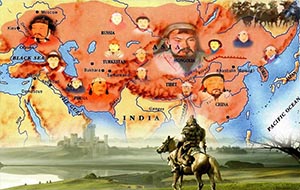Introduction
Nestled within the vast Mongolian steppes, where history whispers through the winds, stands a monumental tribute to a legendary conqueror. The Genghis Khan Statue, a colossal equestrian monument, beckons travelers to the heart of Mongolia, inviting them to delve into the enigmatic past of the Great Khan. Join us on an insider's journey as we unveil the secrets of this iconic statue and its significance in the heart of the Mongolian wilderness.
A Tribute Fit for a Conqueror
The Genghis Khan Statue, also known as "Chinggis Khaan" in Mongolia, is not just a mere work of art but a testament to the enduring legacy of a man who once ruled the largest empire in history. Commissioned in 2008 to commemorate the 800th anniversary of Genghis Khan's unification of the Mongolian tribes, the statue is a tribute fit for a conqueror of his stature.
Size Matters: A Colossal Equestrian Statue
Standing at a staggering 40 meters (131 feet) in height, the Genghis Khan Statue dwarfs other equestrian monuments around the world, including the Statue of Liberty in the United States. The impressive structure is made primarily of stainless steel and was designed by sculptor D. Erdenebileg. The monumental horseman gazes resolutely into the distance, symbolizing Genghis Khan's unwavering determination and vision.
Secrets Beneath the Surface
While the exterior of the statue is awe-inspiring, there are secrets hidden beneath its surface. Inside the monument, there's a museum that tells the story of Genghis Khan's life, his rise to power, and his enduring impact on Mongolian history. Visitors can explore the interactive exhibits, artifacts, and artworks that shed light on the life of this iconic leader.
A Spectacular Location
The location of the Genghis Khan Statue is nothing short of spectacular. It stands at neaby his birthplace, where he spent his childhood before he built the Mongolian empire. Surrounded by the pristine Mongolian steppe, the statue captures the essence of the nomadic way of life that Genghis Khan and his warriors once lived.
A Symbol of Mongolian Identity
For the people of Mongolia, the Genghis Khan Statue is not just a tourist attraction but a symbol of national identity and pride. Genghis Khan, born as Temüjin, is revered as the father of the Mongol nation. His leadership, military genius, and legacy continue to inspire Mongolians today, and the statue serves as a constant reminder of their rich history.
The Horseman's Legacy
Genghis Khan is renowned for his remarkable leadership and his role in shaping the course of history. His empire stretched from the Pacific Ocean to the Mediterranean Sea, leaving an indelible mark on the world. The Genghis Khan Statue stands as a tribute to the enduring legacy of this extraordinary leader, who brought together disparate Mongol tribes and built an empire that would stand the test of time.
Conclusion
The Genghis Khan Statue in Mongolia is not merely a tourist attraction but a tribute to a man who changed the course of history. With its colossal size, breathtaking location, and rich historical context, it invites visitors to immerse themselves in the mystique of Genghis Khan's legacy and the enduring spirit of the Mongolian people. As you stand in the shadow of this awe-inspiring monument, you can't help but be transported back in time, to an era when Genghis Khan and his horsemen rode across the steppes, leaving an indelible mark on the world. It's a journey through history that every traveler should undertake, for the secrets of the Genghis Khan Statue are waiting to be uncovered by those who dare to explore the heart of Mongolia.








































